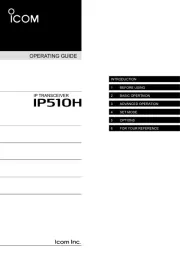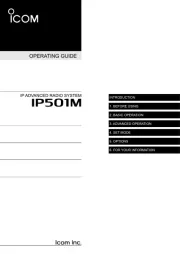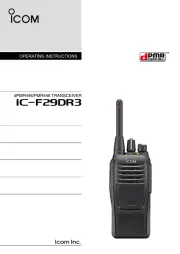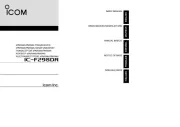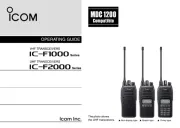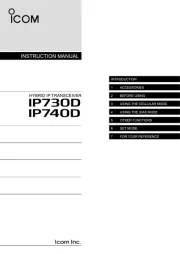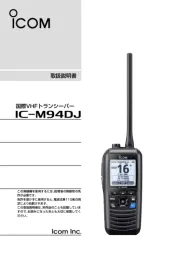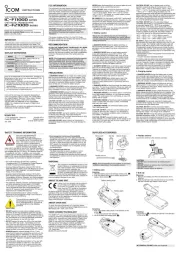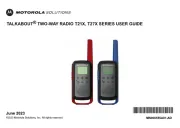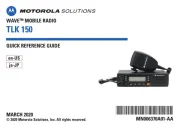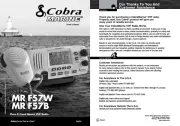
Thank you for choosing this Icom product.
READ ALL INSTRUCTIONS carefully and completely
before using this product.
1-1-32 Kamiminami, Hirano-ku,
SAVE THESE INSTRUCTIONS— These instructions
contain basic (important) operating instructions for the
IC-F1000/IC-F1000S/IC-F1000T VHF TRANSCEIVERS or
IC-F2000/IC-F2000S/IC-F2000T UHF TRANSCEIVERS.
Personal death, serious injury or an
Personal injury, re hazard or electric
Equipment damage may occur.
Recommended for optimum use. No risk
of personal injury, re or electric shock.
Icom is not responsible for the destruction, damage to, or
performance of any Icom or non-Icom equipment, if the
malfunction is because of:
•Force majeure, including, but not limited to, fires,
earthquakes, storms, floods, lightning, other natural
disasters, disturbances, riots, war, or radioactive
•The use of Icom transceivers with any equipment that is
not manufactured or approved by Icom.
Icom and the Icom logo are registered trademarks of
Icom Incorporated (Japan) in Japan, the United States,
the United Kingdom, Germany, France, Spain, Russia,
Australia, New Zealand, and/or other countries.
All other products or brands are registered trademarks or
trademarks of their respective holders.
This equipment has been tested and found to comply with
the limits for a Class A digital device, pursuant to part 15
of the FCC Rules. These limits are designed to provide
reasonable protection against harmful interference when
the equipment is operated in a commercial environment.
This equipment generates, uses, and can radiate
radio frequency energy and, if not installed and used
in accordance with the instruction manual, may cause
harmful interference to radio communications. Operation
of this equipment in a residential area is likely to cause
harmful interference in which case the user will be
required to correct the interference at his own expense.
CAUTION: Changes or modications to this transceiver,
not expressly approved by Icom Inc., could void
your authority to operate this transceiver under FCC
This device complies with Part 15 of the FCC Rules.
Operation is subject to the condition that this device does
not cause harmful interference.
CLEAN THE TRANSCEIVER THOROUGHLY IN A BOWL
OF FRESH WATER after exposure to saltwater, and dry
it before operating. Otherwise, the transceiver’s keys and
switches may become unusable, due to salt crystallization,
and/or the charging terminals of the battery pack may
NOTE: If the transceiver’s waterproof protection appears
defective, carefully clean the transceiver with a soft,
damp (fresh water) cloth, then dry it before operating.
The transceiver may lose its waterproof protection if the
case, jack cap, or connector cover is cracked or broken,
or the transceiver has been dropped.
Contact your Icom distributor or your dealer for advice.
RDANGER! NEVER short terminals (or charging terminals)
of the battery pack. Also, current may ow into nearby
metal objects such as a key, so be careful when placing the
battery packs (or the transceiver) in handbags, and so on.
Simply carrying with or placing near metal objects such as
a key, and so on may cause shorting. This may damage not
only the battery pack, but also the transceiver.
RDANGER! Use and charge only specied Icom battery
packs with Icom transceivers or Icom chargers. Only Icom
battery packs are tested and approved for use with Icom
transceivers or charged with Icom chargers. Using third-
party or counterfeit battery packs or chargers may cause
smoke, re, or cause the battery to burst.
RWARNING! NEVER hold the transceiver so that the
antenna is very close to, or touching exposed parts of the
body, especially the face or eyes, while transmitting. The
transceiver will perform best if the microphone is 5 to 10
cm (2 to 4 inches) away from the lips and the transceiver
RWARNING! NEVER operate the transceiver with a
headset or other audio accessories at high volume levels.
The continuous high volume operation may cause a
ringing in your ears. If you experience the ringing, reduce
the volume level or discontinue use.
RWARNING! NEVER operate the transceiver while
driving a vehicle. Safe driving requires your full attention—
anything less may result in an accident.
CAUTION: MAKE SURE the exible antenna, battery pack,
and jack cover are securely attached to the transceiver,
and that the antenna and battery pack are dry before
attachment. Exposing the inside of the transceiver to dust
or water will result in serious damage to the transceiver.
NEVER place the transceiver in an insecure place to avoid
inadvertent use by unauthorized persons.
DO NOT operate the transceiver near unshielded electric
blasting caps or in an explosive atmosphere.
DO NOT push [PTT] when you do not actually intend to
DO NOT operate or place the transceiver in direct sunlight
or in areas with temperatures below –25°C (–13°F) or
above +55°C (+131°F): ETS version, below –30°C (–22°F)
or above +60°C (+140°F): TIA version.
DO NOT modify the transceiver. The specications may
change and then not comply with the requirements of a
corresponded regulation. The transceiver warranty does not
cover any problems caused by unauthorized modication.
DO NOT use harsh solvents such as benzine or alcohol
when cleaning, as they will damage the transceiver surfaces.
BE CAREFUL! The transceiver will become hot when
operating it continuously for long periods of time.
BE CAREFUL! The transceiver meets IP67* requirements
for dust-tight and waterproof protection.
However, once the transceiver has been dropped, dust-
tight and waterproof protection cannot be guaranteed
because of possible damage to the transceiver’s case or
Only when the jack cover, the optional HM-222HLWP,
HS-94LWP, or HS-95LWP is attached.
Even when the transceiver power is OFF, a slight current
still ows in the circuits. Remove the battery pack from the
transceiver when not using it for a long time. Otherwise,
the installed battery pack will become exhausted, and will
need to be recharged or replaced.
MAKE SURE to turn OFF the transceiver power before
connecting or disconnecting the supplied or optional
Misuse of Li-ion batteries may result in the following
hazards: smoke, re, or the battery may rupture. Misuse
can also cause damage to the battery or degradation of
RDANGER! DO NOT hammer or otherwise impact the
battery. Do not use the battery if it has been severely
impacted or dropped, or if the battery has been subjected
to heavy pressure. Battery damage may not be visible on
the outside of the case. Even if the surface of the battery
does not show cracks or any other damage, the cells
inside the battery may rupture or catch re.
RDANGER! NEVER use or leave battery pack in
areas with temperatures above +60°C (+140°F). High
temperature buildup in the battery, such as could occur
near res or stoves, inside a sun-heated vehicle, or in
direct sunlight for long periods of time may cause the
battery to rupture or catch re. Excessive temperatures
may also degrade battery’s performance or shorten battery
RDANGER! DO NOT expose the battery to rain, snow,
seawater, or any other liquids. Do not charge or use a wet
battery. If the battery gets wet, be sure to wipe it dry before
RDANGER! KEEP battery packs away from re. Fire or
heat may cause them to rupture or explode. Dispose of an
used battery pack in accordance with local regulations.
RDANGER! NEVER solder the battery terminals, or modify
the battery pack. This may generate heat in the battery, and
the battery pack may burst, emit smoke or catch re.
RDANGER! Use the battery only with the transceiver for
which it is specied. Never use a battery with any other
equipment, or for any purpose that is not specied in the
RDANGER! If uid from inside the battery gets in your
eyes, blindness can result. Rinse your eyes with clean
water, without rubbing them, and see a doctor immediately.
RWARNING! Immediately stop using the battery if it emits
an abnormal odor, heats up, or is discolored or deformed.
If any of these conditions occur, contact your Icom dealer
RWARNING! NEVER use deteriorated battery packs.
RWARNING! Immediately wash, using clean water, any
part of the body that comes into contact with uid from
RWARNING! NEVER put the battery in a microwave
oven, high-pressure container, or in an induction heating
cooker. This could cause a re, overheating, or cause the
CAUTION: Always use the battery within the specied
temperature range, for the transceiver –25°C to +55°C
(–13°F to +131°F): ETS version, –30°C to +60°C (–22°F to
+140°F): TIA version, and the battery itself –20°C to +60°C
(–4°F to +140°F). Using the battery out of its specied
temperature range will reduce the battery’s performance
and battery life. Please note that the specied temperature
range of the battery may exceed that of the transceiver.
In such cases, the transceiver may not work properly
because it is out of its operating temperature range.
CAUTION: Shorter battery life could occur if the battery
is left fully charged, completely discharged, or in an
excessive temperature environment (above +50°C;
+122°F) for an extended period of time. If the battery must
be left unused for a long time, it must be detached from
the transceiver after discharging. You may use the battery
until the remaining capacity is about half, then keep it
safely in a cool dry place at the following temperature
–20°C (–4°F) to +50°C (+122°F) (within a month)
–20°C (–4°F) to +40°C (+104°F) (within three months)
–20°C (–4°F) to +20°C (+68°F) (within a year)
BE SURE to replace the battery pack with a new one
approximately ve years after manufacturing, even if it still
holds a charge. The inside battery material will become
weak after a period of time, even with little use. The
estimated number of times you can charge the battery is
between 300 and 500. Even when the battery appears to
be fully charged, the operating time of the transceiver may
• Approximately five years have passed since the battery
•The battery has been repeatedly charged.
The battery cells may deteriorate and swell due to their
characteristics if used in an environment and conditions
such as: frequently charged, recharged immediately after
full charge, used or saved in a hot place, or charged
by methods other than the instructions. If the battery
pack swells, it has reached the end of its life due to
deterioration. Replace it with a brand new one.
RDANGER! NEVER charge the battery pack in areas
with extremely high temperatures, such as near res or
stoves, inside a sun-heated vehicle, or in direct sunlight.
In such environments, the safety/protection circuit in the
battery will activate, causing the battery to stop charging.
RDANGER! NEVER charge the transceiver during a
lightning storm. It may result in an electric shock, cause
a re or damage the transceiver. Always disconnect the
power adapter before a storm.
RWARNING! NEVER charge or leave the battery in the
battery charger beyond the specied time for charging. If
the battery is not completely charged by the specied time,
stop charging and remove the battery from the battery
charger. Continuing to charge the battery beyond the
specied time limit may cause a re, overheating, or the
RWARNING! Occasionally observe the battery pack
condition while charging. If any abnormal condition occurs,
discontinue using the battery pack.
RWARNING! NEVER insert the transceiver (battery
attached to the transceiver) into the charger if it is wet or
soiled. This could rust the battery charger terminals or
damage the charger. The charger is not waterproof.
NOTE: Charge the battery within the specied temperature
range of +10°C to +40°C (+50°F to +104°F). Otherwise,
the charging time will be longer, but the battery will not
reach a full charge. While charging, at a point after the
temperature goes out of the specied range, the charging
SAFETY TRAINING INFORMATION
Your Icom radio generates RF
electromagnetic energy during transmit
mode. This radio is designed for and
classied as “Occupational Use Only”,
meaning it must be used only during the
course of employment by individuals
aware of the hazards, and the ways to
minimize such hazards. This radio is
NOT intended for use by the “General Population” in an
uncontrolled environment. This radio has been tested and
complies with the FCC and IC RF exposure limits for
“Occupational Use Only”. In addition, your Icom radio
complies with the following Standards and Guidelines with
regard to RF energy and electromagnetic energy levels
and evaluation of such levels for exposure to humans:
• FCC OET Bulletin 65 Edition 97-01 Supplement C,
Evaluating Compliance with FCC Guidelines for Human
Exposure to Radio Frequency Electromagnetic Fields.
• American National Standards Institute (C95.1-2019),
IEEE Standard for Safety Levels with Respect to Human
Exposure to Electric, Magnetic, and Electromagnetic
• American National Standards Institute (C95.3-2021),
IEEE Recommended Practice for Measurements and
Computations of Electric, Magnetic, and Electromagnetic
Fields with Respect to Human Exposure to Such Fields,
• The antennas, batteries, belt clips, speaker-microphone,
and other accessories that are listed in “OPTIONS”
of the INSTRUCTIONS sheet, are authorized for use
with this product. Use of accessories other than those
specified may result in RF exposure levels exceeding
the FCC and IC requirements for wireless RF exposure.
To ensure that your expose to RF
electromagnetic energy is within the
FCC and IC allowable limits for
occupational use, always adhere to the
• operate the radio without a proper antenna DO NOT
attached, as this may damaged the radio and may also
cause you to exceed FCC and IC RF exposure limits. A
proper antenna is the antenna supplied with this radio by
the manufacturer or antenna specifically authorized by
the manufacturer for use with this radio.
• transmit for more than 50% of total radio DO NOT
use time (“50% duty cycle”). Transmitting more than
50% of the time can cause FCC and IC RF exposure
compliance requirements to be exceeded. The radio is
transmitting when the LED indicator lights red. You can
cause the radio to transmit by pressing the “PTT” switch.
• ALWAYS keep the antenna at least 2.5 cm (1 inch) away
from the body when transmitting and only use the Icom
belt-clips listed in “OPTIONS” of the INSTRUCTIONS
sheet when attaching the radio to your belt, etc.,
to ensure FCC and IC RF exposure compliance
requirements are not exceeded. To provide the recipients
of your transmission the best sound quality, hold the
antenna at least 5 cm (2 inches) from your mouth, and
slightly off to one side.
The information listed above provides the user with
the information needed to make him or her aware of
RF exposure, and what to do to assure that this radio
operates with the FCC and IC RF exposure limits of this
•Electromagnetic Interference/Compatibility
During transmissions, your Icom radio generates RF
energy that can possibly cause interference with other
devices or systems. To avoid such interference, turn o
the radio in areas where signs are posted to do so. DO
NOT operate the transmitter in areas that are sensitive to
electromagnetic radiation such as hospitals, aircraft, and
•Occupational/Controlled Use
The radio transmitter is used in situations in which
persons are exposed as consequence of their
employment provided those persons are fully aware of
the potential for exposure and can exercise control over
Hereby, Icom Inc. declares that the versions
of IC-F1000, IC-F1000S, IC-F1000T,
IC-F2000, IC-F2000S, and IC-F2000T which
have the “CE” symbol on the product,
comply with the essential requirements of
the Radio Equipment Directive, 2014/53/EU, and the
restriction of the use of certain hazardous substances in
electrical and electronic equipment Directive, 2011/65/EU.
The full text of the EU declaration of conformity is available
at the following internet address:
https://www.icomjapan.com/support/
The crossed-out wheeled-bin symbol on your
product, literature, or packaging reminds you
that in the European Union, all electrical and
electronic products, batteries, and
accumulators (rechargeable batteries) must
be taken to designated collection locations at
the end of their working life. Do not dispose
of these products as unsorted municipal waste. Dispose of
them according to the laws in your area.
Battery pack Belt clip Battery charger
•Some accessories are not supplied, or the shape is
dierent, depending on the transceiver version.
•The FA-SC55V supplied with some VHF transceiver
versions covers only the range of 150 MHz to
174 MHz. Purchase a suitable antenna to use the
transceiver between the 136 MHz and 150 MHz
frequency range. See OPTIONS for details.
To obtain the UKCA Declaration of Conformity, please
contact Icom UK Limited by email at info@icomuk.co.uk or
alternatively call + 44(0) 1227 741741.
